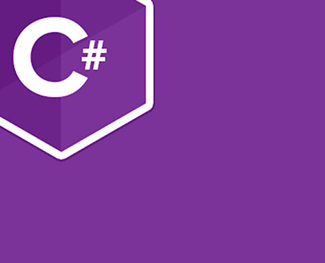Thêm, sửa, xóa user trong C# Winforms
Trong bài viết này mình sẽ hướng dẫn các bạn cách thêm, sửa, xóa các user trong SQL Server với C# Winforms. Đây là các thao tác không thể thiếu trong một ứng dụng.

Để hiểu được bài này, các bạn cần có kiến thức cơ bản về Winforms và SQL Server, vậy nên hãy tìm hiểu nó trước đã nhé. Còn bây giờ, cùng mình viết một ứng dụng nhỏ để thao tác thêm, sửa, xóa các user trong C# Winforms nào.
1. Tạo form giao diện thêm, sửa, xóa user trong C#
Việc đầu tiên chúng ta cần tạo form giao diện thêm, sửa, xóa user.
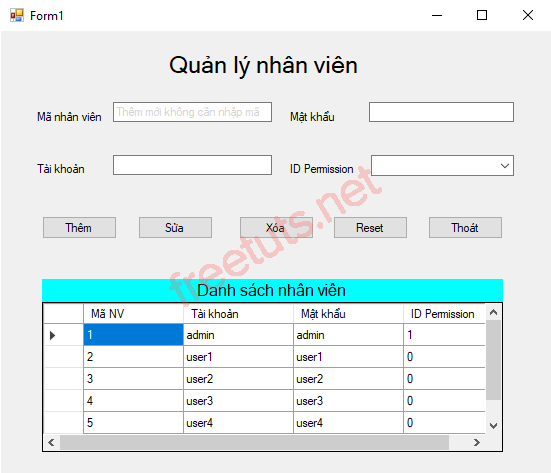
Ở đây có một số control quan trọng như:
Bài viết này được đăng tại [free tuts .net]
- Các ô TextBox để người dùng nhập vào thông tin và để hiển thị thông tin khi người dùng chọn vào user ở bảng hiển thị.
- ComboBox với hai giá trị là 0 và 1, nếu là 0 là quyền truy cập của admin và 1 là quyền truy cập của user.
- Button "Thêm" sẽ thêm mới một user nếu thõa mãn các điều kiện. Lưu ý khi thêm thì không cần nhập mã vì mã sẽ tăng tự động.
- Butotn "Sửa" sẽ sửa đổi thông tin với mã được nhập trong TextBox "Mã nhân viên". Nếu không có mã thì sẽ thông báo cho người dùng viết để nhập mã.
- Button "Xóa" sẽ xóa một user được chọn trong bảng hiển thị.
- Button "Reset" sẽ xóa các thông tin được nhập trong TextBox.
- Button "Thoát" yêu cầu người dùng xác nhận có thoát ứng dụng hay không.
- DataGridView sẽ hiển thị danh sách user khi vừa bắt đầu chạy ứng dụng.
*Lưu ý: Cứ sau mỗi thao tác thì DataGridView sẽ cập nhật lại dữ liệu từ SQL Server.
2. Tạo database và Stored Procedure
Ở đây mình sẽ sử dụng database QLNhanVien, các bạn có thể sử dụng đoạn code dưới đây để tạo database và thêm các dữ liệu trong database nhé.
Create database [QLNhanVien] GO USE [QLNhanVien] GO /****** Object: Table [dbo].[NhanVien] Script Date: 8/13/2021 5:44:21 PM ******/ SET ANSI_NULLS ON GO SET QUOTED_IDENTIFIER ON GO CREATE TABLE [dbo].[NhanVien]( [MaNV] [int] IDENTITY(1,1) NOT NULL, [TaiKhoan] [nvarchar](50) NOT NULL, [MatKhau] [nvarchar](50) NOT NULL, [IDPer] [int] NOT NULL, CONSTRAINT [PK_NhanVien] PRIMARY KEY CLUSTERED ( [MaNV] ASC )WITH (PAD_INDEX = OFF, STATISTICS_NORECOMPUTE = OFF, IGNORE_DUP_KEY = OFF, ALLOW_ROW_LOCKS = ON, ALLOW_PAGE_LOCKS = ON) ON [PRIMARY] ) ON [PRIMARY] GO

Trong ứng dụng của chúng ta có 4 thao tác chính đó là thêm, sửa, xóa và hiển thị user vào DataGridView. Vì vậy ta sẽ tạo 4 Stored Procedure trong SQL Server để lát nữa sử dụng nó từ C#.
Stored Procedure lấy user:
create proc [dbo].[SP_Retrieve_User] as begin select * from NhanVien end
Stored Procedure thêm user:
create proc [dbo].[SP_ThemNhanVien] @TaiKhoan nvarchar(50), @MatKhau nvarchar(50), @IDPer int as begin Insert into NhanVien values(@TaiKhoan,@MatKhau,@IDPer) end
Stored Procedure sửa user:
create proc [dbo].[SP_SuaNhanVien] @MaNV int, @TaiKhoan nvarchar(50), @MatKhau nvarchar(50), @IDPer int as begin update NhanVien set TaiKhoan =@TaiKhoan, MatKhau = @MatKhau, IDPer = @IDPer where MaNV = @MaNV end
Stored Procedure xóa user:
create proc [dbo].[SP_XoaNhanVien] @MaNV int as begin delete NhanVien where MaNV = @MaNV end
3. Xử lý các sự kiện trên form
Sau khi đã tạo xong giao diện form và các Proc, thì bây giờ bắt đầu xử lý các sự kiện trên form.
Hiển thị user trên DataGridView
Để dữ liệu hiển thị ngay khi ứng dụng chạy, ta sẽ viết ở sự kiện Form_Load, các bạn có thể xem lại cách hiển thị dữ liệu từ SQL.
Ở đây mình sẽ tạo một hàm LayDSUser() để lấy các user từ SQL Server. Sở dĩ mình tạo một hàm riêng là vì ở các thao tác bên dưới, mình sẽ gọi hàm lấy user này để sử dụng lại khi cần thiết.
private void LayDSUser()
{
//khởi tạo các đối tượng SqlConnection, SqlDataAdapter, DataTable
SqlConnection conn = new SqlConnection();
SqlDataAdapter da = new SqlDataAdapter();
DataTable dt = new DataTable();
//lấy chuỗi kết nối từ file App.config
conn.ConnectionString = ConfigurationManager.ConnectionStrings["conStr"].ConnectionString;
try
{
//mở chuỗi kết nối
conn.Open();
//khai báo đối tượng SqlCommand trong SqlDataAdapter
da.SelectCommand = new SqlCommand();
//gọi thủ tục từ SQL
da.SelectCommand.CommandText = "SP_Retrieve_User";
da.SelectCommand.CommandType = CommandType.StoredProcedure;
//gán chuỗi kết nối
da.SelectCommand.Connection = conn;
//sử dụng phương thức fill để điền dữ liệu từ datatable vào SqlDataAdapter
da.Fill(dt);
//gán dữ liệu từ datatable vào datagridview
dtgDSNV.DataSource = dt;
//đóng chuỗi kết nối
conn.Close();
//sử dụng thuộc tính Width và HeaderText để set chiều dài và tiêu đề cho các coloumns
dtgDSNV.Columns[0].Width = 100;
dtgDSNV.Columns[0].HeaderText = "Mã NV";
dtgDSNV.Columns[1].Width = 110;
dtgDSNV.Columns[1].HeaderText = "Tài khoản";
dtgDSNV.Columns[2].Width = 110;
dtgDSNV.Columns[2].HeaderText = "Mật khẩu";
dtgDSNV.Columns[3].Width = 100;
dtgDSNV.Columns[3].HeaderText = "ID Permission";
}
catch (Exception ex)
{
MessageBox.Show(ex.Message);
}
}Sau khi gọi chuỗi kết nối và sử dụng Proc SP_Retrieve_User để lấy dữ liệu, mình tạo thêm các columns với độ dài và tiêu đề.
Bây giờ chỉ cần gọi hàm LayDSUser() vừa được viết ở sự kiện Form_Load để hiển thị ngay khi chạy chương trình.
private void Form1_Load(object sender, EventArgs e)
{
LayDSUser();
}Kết quả:

Xử lý sự kiện Cell_Click trên DataGridView
Khi người dùng click chọn vào bất kì user nào thì thông tin của user đó sẽ hiển thị lên các TextBox tương ứng ở phía trên.
private void dtgDSNV_CellClick(object sender, DataGridViewCellEventArgs e)
{
DataGridViewRow row = new DataGridViewRow();
row = dtgDSNV.Rows[e.RowIndex];
txtMaNV.Text = Convert.ToString(row.Cells["MaNV"].Value);
txtTaiKhoan.Text = Convert.ToString(row.Cells["TaiKhoan"].Value);
txtMatKhau.Text = Convert.ToString(row.Cells["MatKhau"].Value);
cboPer.Text = Convert.ToString(row.Cells["IDPer"].Value);
}Xử lý sự kiện button "Thêm"
Ở button "Thêm" ta quan tâm đến 3 tham số đó là tên tài khoản, mật khẩu và ID Permission. Ta cần lấy các thông tin này từ người dùng để đưa vào SQL Server, vậy nên sẽ viết một hàm kiểm tra xem người dùng đã nhập đầy đủ hay chưa.
public bool KiemTraThongTin()
{
if (txtTaiKhoan.Text == "")
{
MessageBox.Show("Vui lòng nhập tài khoản nhân viên", "Thông báo", MessageBoxButtons.OK, MessageBoxIcon.Information);
txtTaiKhoan.Focus();
return false;
}
if (txtMatKhau.Text == "")
{
MessageBox.Show("Vui lòng nhập mật khẩu nhân viên", "Thông báo", MessageBoxButtons.OK, MessageBoxIcon.Information);
txtMatKhau.Focus();
return false;
}
if (cboPer.Text == "")
{
MessageBox.Show("Vui lòng chọn quyền cho nhân viên", "Thông báo", MessageBoxButtons.OK, MessageBoxIcon.Information);
cboPer.Focus();
return false;
}
return true;
}
Sau khi kiểm tra đã đầy đủ các thông tin cần thiết, chúng ta sẽ bắt đầu gọi Proc SP_ThemNhanVien từ C# bằng đối tượng SqlCommand.
private void btnThem_Click(object sender, EventArgs e)
{
if (KiemTraThongTin())
{
try
{
SqlConnection conn = new SqlConnection();
conn.ConnectionString = ConfigurationManager.ConnectionStrings["conStr"].ConnectionString;
SqlCommand cmd = new SqlCommand();
cmd.CommandText = "SP_ThemNhanVien";
cmd.CommandType = CommandType.StoredProcedure;
cmd.Parameters.Add("@TaiKhoan", SqlDbType.NVarChar).Value = txtTaiKhoan.Text;
cmd.Parameters.Add("@MatKhau", SqlDbType.NVarChar).Value = txtMatKhau.Text;
cmd.Parameters.Add("@IDPer", SqlDbType.Int).Value = Convert.ToInt32(cboPer.Text);
cmd.Connection = conn;
conn.Open();
cmd.ExecuteNonQuery();
conn.Close();
LayDSUser();
Reset();
MessageBox.Show("Đã thêm mới nhân viên thành công", "Thông báo", MessageBoxButtons.OK, MessageBoxIcon.Information);
}
catch (Exception ex)
{
MessageBox.Show(ex.Message);
}
}
}Kết quả:
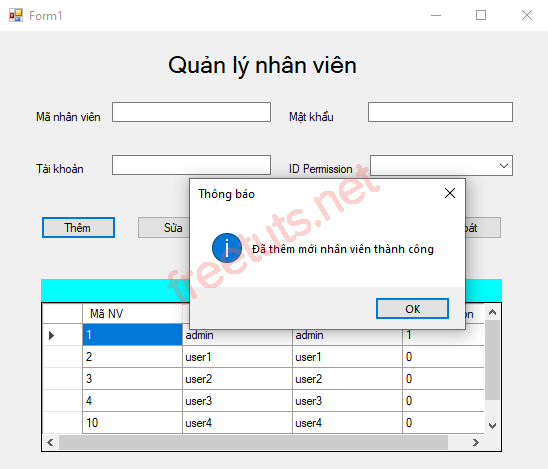
Xử lý sự kiện button "Sửa"
Tương tự như button "Thêm", ở sự kiện này ta cần thêm một tham số nữa đó chính là mã nhân viên (mã user). Và cũng sử dụng hàm KiemTraThongTin() để kiểm tra xem người dùng đã nhập đầy đủ hay chưa.
private void btnSua_Click(object sender, EventArgs e)
{
if (txtMaNV.Text == "")
{
MessageBox.Show("Vui lòng nhập mã nhân viên cần sửa", "Thông báo", MessageBoxButtons.OK, MessageBoxIcon.Information);
txtMaNV.Focus();
}
else if (KiemTraThongTin())
{
try
{
SqlConnection conn = new SqlConnection();
conn.ConnectionString = ConfigurationManager.ConnectionStrings["conStr"].ConnectionString;
SqlCommand cmd = new SqlCommand();
cmd.CommandText = "SP_SuaNhanVien";
cmd.CommandType = CommandType.StoredProcedure;
cmd.Parameters.Add("@MaNV", SqlDbType.Int).Value = Convert.ToInt32(txtMaNV.Text);
cmd.Parameters.Add("@TaiKhoan", SqlDbType.NVarChar).Value = txtTaiKhoan.Text;
cmd.Parameters.Add("@MatKhau", SqlDbType.NVarChar).Value = txtMatKhau.Text;
cmd.Parameters.Add("@IDPer", SqlDbType.Int).Value = Convert.ToInt32(cboPer.Text);
cmd.Connection = conn;
conn.Open();
cmd.ExecuteNonQuery();
conn.Close();
LayDSUser();
Reset();
MessageBox.Show("Đã sửa nhân viên thành công", "Thông báo", MessageBoxButtons.OK, MessageBoxIcon.Information);
}
catch (Exception ex)
{
MessageBox.Show(ex.Message);
}
}
}Kết quả:
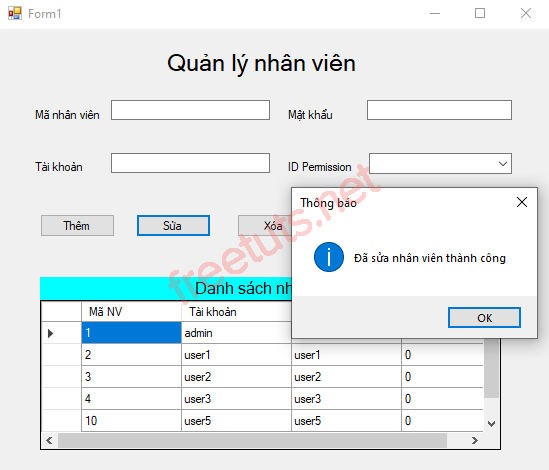
Xử lý sự kiện button "Xóa"
Để xóa một user ta chỉ cần một tham số đó chính là mã nhân viên (mã user) mà thôi. Vậy nên nó sẽ đơn giản hơn hai thao tác trên.
*Lưu ý: Để đảm bảo rằng người dùng muốn xóa và không ấn nhầm, thì ta sẽ thêm một hộp thoại yêu cầu xác nhận khi người dùng muốn xóa user.
private void btnXoa_Click(object sender, EventArgs e)
{
if (txtMaNV.Text == "")
{
MessageBox.Show("Vui lòng nhập mã nhân viên cần xóa", "Thông báo", MessageBoxButtons.OK, MessageBoxIcon.Information);
txtMaNV.Focus();
}
else
{
try
{
SqlConnection conn = new SqlConnection();
conn.ConnectionString = ConfigurationManager.ConnectionStrings["conStr"].ConnectionString;
SqlCommand cmd = new SqlCommand();
cmd.CommandText = "SP_XoaNhanVien";
cmd.CommandType = CommandType.StoredProcedure;
cmd.Parameters.Add("@MaNV", SqlDbType.Int).Value = Convert.ToInt32(txtMaNV.Text);
cmd.Connection = conn;
conn.Open();
DialogResult dg = MessageBox.Show("Bạn có chắn chắn muốn xóa?", "Thông báo", MessageBoxButtons.YesNo, MessageBoxIcon.Question);
if (dg == DialogResult.Yes)
{
cmd.ExecuteNonQuery();
}
conn.Close();
LayDSUser();
Reset();
MessageBox.Show("Đã xóa nhân viên thành công", "Thông báo", MessageBoxButtons.OK, MessageBoxIcon.Information);
}
catch (Exception ex)
{
MessageBox.Show(ex.Message);
}
}
}Kết quả:
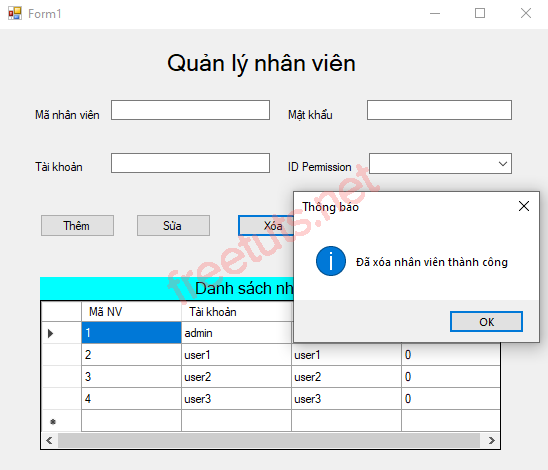
Xử lý sự kiện button "Reset"
Sự kiện này chỉ đơn giản là xóa hết các thông tin đang hiển thị trên các TextBox và ComboBox.
*Lưu ý: Mình đã viết riêng một hàm Reset() để sử dụng cho các thao tác ở trên sau khi thêm, sửa, xóa.
public void Reset()
{
txtMaNV.Text = "";
txtMatKhau.Text = "";
txtTaiKhoan.Text = "";
cboPer.Text = "";
}
private void btnReset_Click(object sender, EventArgs e)
{
Reset();
}Xử lý sự kiện button "Thoát"
Và cuối cùng sẽ là sự kiện ở button "Thoát", sự kiện này thì hầu như bài nào mình cũng có nhắc đến. Bởi vì tính thông dụng của nó, hầu như các ứng nào cũng đều sử dụng button này.
private void btnThoat_Click(object sender, EventArgs e)
{
//sử dụng DialogResult để kiểm tra kết quả trả về và hiển thị hộp thoại thông báo
DialogResult dg = MessageBox.Show("Bạn có muốn thoát?", "Thông báo", MessageBoxButtons.YesNo, MessageBoxIcon.Question);
if (dg == DialogResult.Yes)
{
Application.Exit();
}
}kết quả:
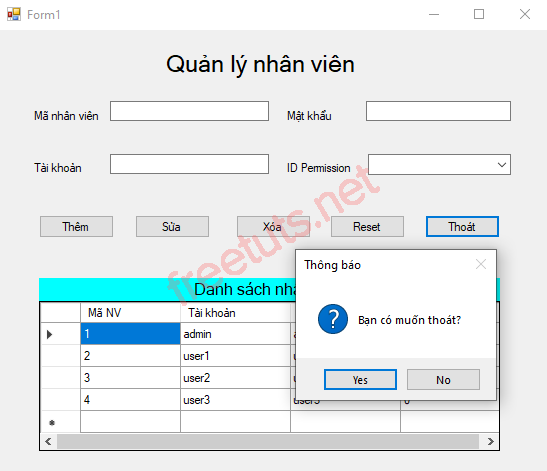
4. Code hoàn chỉnh thêm, sửa, xóa user trong Winforms
using System;
using System.Collections.Generic;
using System.ComponentModel;
using System.Configuration;
using System.Data;
using System.Data.SqlClient;
using System.Drawing;
using System.Linq;
using System.Text;
using System.Threading.Tasks;
using System.Windows.Forms;
namespace Example
{
public partial class Form1 : Form
{
public Form1()
{
InitializeComponent();
}
private void LayDSUser()
{
//khởi tạo các đối tượng SqlConnection, SqlDataAdapter, DataTable
SqlConnection conn = new SqlConnection();
SqlDataAdapter da = new SqlDataAdapter();
DataTable dt = new DataTable();
//lấy chuỗi kết nối từ file App.config
conn.ConnectionString = ConfigurationManager.ConnectionStrings["conStr"].ConnectionString;
try
{
//mở chuỗi kết nối
conn.Open();
//khai báo đối tượng SqlCommand trong SqlDataAdapter
da.SelectCommand = new SqlCommand();
//gọi thủ tục từ SQL
da.SelectCommand.CommandText = "SP_Retrieve_User";
da.SelectCommand.CommandType = CommandType.StoredProcedure;
//gán chuỗi kết nối
da.SelectCommand.Connection = conn;
//sử dụng phương thức fill để điền dữ liệu từ datatable vào SqlDataAdapter
da.Fill(dt);
//gán dữ liệu từ datatable vào datagridview
dtgDSNV.DataSource = dt;
//đóng chuỗi kết nối
conn.Close();
//sử dụng thuộc tính Width và HeaderText để set chiều dài và tiêu đề cho các coloumns
dtgDSNV.Columns[0].Width = 100;
dtgDSNV.Columns[0].HeaderText = "Mã NV";
dtgDSNV.Columns[1].Width = 110;
dtgDSNV.Columns[1].HeaderText = "Tài khoản";
dtgDSNV.Columns[2].Width = 110;
dtgDSNV.Columns[2].HeaderText = "Mật khẩu";
dtgDSNV.Columns[3].Width = 100;
dtgDSNV.Columns[3].HeaderText = "ID Permission";
}
catch (Exception ex)
{
MessageBox.Show(ex.Message);
}
}
private void Form1_Load(object sender, EventArgs e)
{
LayDSUser();
}
private void btnThoat_Click(object sender, EventArgs e)
{
//sử dụng DialogResult để kiểm tra kết quả trả về và hiển thị hộp thoại thông báo
DialogResult dg = MessageBox.Show("Bạn có muốn thoát?", "Thông báo", MessageBoxButtons.YesNo, MessageBoxIcon.Question);
if (dg == DialogResult.Yes)
{
Application.Exit();
}
}
public bool KiemTraThongTin()
{
if (txtTaiKhoan.Text == "")
{
MessageBox.Show("Vui lòng nhập tài khoản nhân viên", "Thông báo", MessageBoxButtons.OK, MessageBoxIcon.Information);
txtTaiKhoan.Focus();
return false;
}
if (txtMatKhau.Text == "")
{
MessageBox.Show("Vui lòng nhập mật khẩu nhân viên", "Thông báo", MessageBoxButtons.OK, MessageBoxIcon.Information);
txtMatKhau.Focus();
return false;
}
if (cboPer.Text == "")
{
MessageBox.Show("Vui lòng chọn quyền cho nhân viên", "Thông báo", MessageBoxButtons.OK, MessageBoxIcon.Information);
cboPer.Focus();
return false;
}
return true;
}
private void btnThem_Click(object sender, EventArgs e)
{
if (KiemTraThongTin())
{
try
{
SqlConnection conn = new SqlConnection();
conn.ConnectionString = ConfigurationManager.ConnectionStrings["conStr"].ConnectionString;
SqlCommand cmd = new SqlCommand();
cmd.CommandText = "SP_ThemNhanVien";
cmd.CommandType = CommandType.StoredProcedure;
cmd.Parameters.Add("@TaiKhoan", SqlDbType.NVarChar).Value = txtTaiKhoan.Text;
cmd.Parameters.Add("@MatKhau", SqlDbType.NVarChar).Value = txtMatKhau.Text;
cmd.Parameters.Add("@IDPer", SqlDbType.Int).Value = Convert.ToInt32(cboPer.Text);
cmd.Connection = conn;
conn.Open();
cmd.ExecuteNonQuery();
conn.Close();
LayDSUser();
Reset();
MessageBox.Show("Đã thêm mới nhân viên thành công", "Thông báo", MessageBoxButtons.OK, MessageBoxIcon.Information);
}
catch (Exception ex) {
MessageBox.Show(ex.Message);
}
}
}
private void btnSua_Click(object sender, EventArgs e)
{
if(txtMaNV.Text == "")
{
MessageBox.Show("Vui lòng nhập mã nhân viên cần sửa", "Thông báo", MessageBoxButtons.OK,MessageBoxIcon.Information);
txtMaNV.Focus();
}
else if (KiemTraThongTin())
{
try
{
SqlConnection conn = new SqlConnection();
conn.ConnectionString = ConfigurationManager.ConnectionStrings["conStr"].ConnectionString;
SqlCommand cmd = new SqlCommand();
cmd.CommandText = "SP_SuaNhanVien";
cmd.CommandType = CommandType.StoredProcedure;
cmd.Parameters.Add("@MaNV", SqlDbType.Int).Value = Convert.ToInt32(txtMaNV.Text);
cmd.Parameters.Add("@TaiKhoan", SqlDbType.NVarChar).Value = txtTaiKhoan.Text;
cmd.Parameters.Add("@MatKhau", SqlDbType.NVarChar).Value = txtMatKhau.Text;
cmd.Parameters.Add("@IDPer", SqlDbType.Int).Value = Convert.ToInt32(cboPer.Text);
cmd.Connection = conn;
conn.Open();
cmd.ExecuteNonQuery();
conn.Close();
LayDSUser();
Reset();
MessageBox.Show("Đã sửa nhân viên thành công", "Thông báo", MessageBoxButtons.OK, MessageBoxIcon.Information);
}
catch (Exception ex)
{
MessageBox.Show(ex.Message);
}
}
}
private void btnXoa_Click(object sender, EventArgs e)
{
if (txtMaNV.Text == "")
{
MessageBox.Show("Vui lòng nhập mã nhân viên cần xóa", "Thông báo", MessageBoxButtons.OK, MessageBoxIcon.Information);
txtMaNV.Focus();
}
else
{
try
{
SqlConnection conn = new SqlConnection();
conn.ConnectionString = ConfigurationManager.ConnectionStrings["conStr"].ConnectionString;
SqlCommand cmd = new SqlCommand();
cmd.CommandText = "SP_XoaNhanVien";
cmd.CommandType = CommandType.StoredProcedure;
cmd.Parameters.Add("@MaNV", SqlDbType.Int).Value = Convert.ToInt32(txtMaNV.Text);
cmd.Connection = conn;
conn.Open();
DialogResult dg = MessageBox.Show("Bạn có chắn chắn muốn xóa?", "Thông báo", MessageBoxButtons.YesNo, MessageBoxIcon.Question);
if (dg == DialogResult.Yes)
{
cmd.ExecuteNonQuery();
}
conn.Close();
LayDSUser();
Reset();
MessageBox.Show("Đã xóa nhân viên thành công", "Thông báo", MessageBoxButtons.OK, MessageBoxIcon.Information);
}
catch (Exception ex)
{
MessageBox.Show(ex.Message);
}
}
}
public void Reset()
{
txtMaNV.Text = "";
txtMatKhau.Text = "";
txtTaiKhoan.Text = "";
cboPer.Text = "";
}
private void btnReset_Click(object sender, EventArgs e)
{
Reset();
}
private void dtgDSNV_CellClick(object sender, DataGridViewCellEventArgs e)
{
DataGridViewRow row = new DataGridViewRow();
row = dtgDSNV.Rows[e.RowIndex];
txtMaNV.Text = Convert.ToString(row.Cells["MaNV"].Value);
txtTaiKhoan.Text = Convert.ToString(row.Cells["TaiKhoan"].Value);
txtMatKhau.Text = Convert.ToString(row.Cells["MatKhau"].Value);
cboPer.Text = Convert.ToString(row.Cells["IDPer"].Value);
}
}
}Như vậy mình đã hướng dẫn xong các thêm, sửa, xóa các user trong C# Winforms. Ở các bài tiếp theo mình sẽ tiếp tục hướng dẫn các thao tác khác với nhiều database khác nhau. Hãy chú ý theo dõi nhé !!!

 Các kiểu dữ liệu trong C ( int - float - double - char ...)
Các kiểu dữ liệu trong C ( int - float - double - char ...)  Thuật toán tìm ước chung lớn nhất trong C/C++
Thuật toán tìm ước chung lớn nhất trong C/C++  Cấu trúc lệnh switch case trong C++ (có bài tập thực hành)
Cấu trúc lệnh switch case trong C++ (có bài tập thực hành)  ComboBox - ListBox trong lập trình C# winforms
ComboBox - ListBox trong lập trình C# winforms 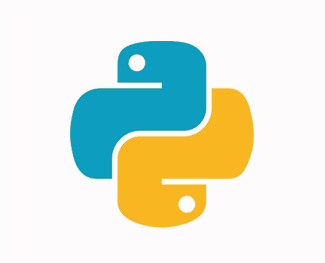 Random trong Python: Tạo số random ngẫu nhiên
Random trong Python: Tạo số random ngẫu nhiên 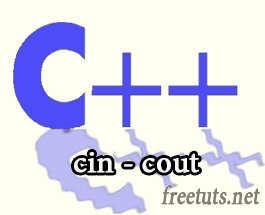 Lệnh cin và cout trong C++
Lệnh cin và cout trong C++  Cách khai báo biến trong PHP, các loại biến thường gặp
Cách khai báo biến trong PHP, các loại biến thường gặp  Download và cài đặt Vertrigo Server
Download và cài đặt Vertrigo Server 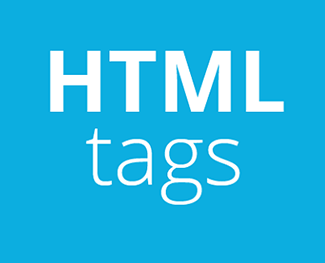 Thẻ li trong HTML
Thẻ li trong HTML  Thẻ article trong HTML5
Thẻ article trong HTML5 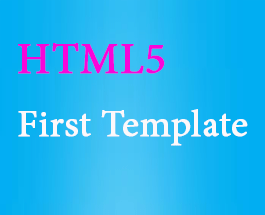 Cấu trúc HTML5: Cách tạo template HTML5 đầu tiên
Cấu trúc HTML5: Cách tạo template HTML5 đầu tiên 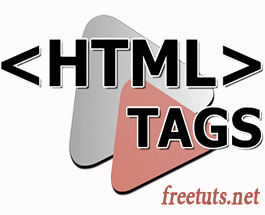 Cách dùng thẻ img trong HTML và các thuộc tính của img
Cách dùng thẻ img trong HTML và các thuộc tính của img  Thẻ a trong HTML và các thuộc tính của thẻ a thường dùng
Thẻ a trong HTML và các thuộc tính của thẻ a thường dùng 